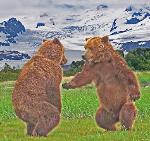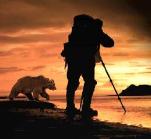Site Visit Counter



| Bright sunny day |
Cloudy day
On a bright sunny day, both snow and glacial ice appear white, making it hard to distinguish the current snowline even from a low-flying
helicopter. However, in diffuse light, glacial ice tends to be blue, whereas snow remains white.
helicopter. However, in diffuse light, glacial ice tends to be blue, whereas snow remains white.



Glacial ice is especially beautiful where all of the rocks, dust and air
bubbles have been squeezed out, leaving the ice almost as clear as
blue-tinted glass -- as is most easily seen when the densest ice from the
bottom of a glacier is exposed by melting or when it calves off as an
iceberg into a lake or ocean at the foot of the glacier.
The transition of ice from white to blue corresponds to the extrusion of
air bubbles and to the change in orientation of the ice crystals from
random to lying in parallel layers, like stacks of poker chips. This results
in ice absorbing some red light, whereas the remaining light, which is
mostly blue, passes through the ice for our eyes to see.
bubbles have been squeezed out, leaving the ice almost as clear as
blue-tinted glass -- as is most easily seen when the densest ice from the
bottom of a glacier is exposed by melting or when it calves off as an
iceberg into a lake or ocean at the foot of the glacier.
The transition of ice from white to blue corresponds to the extrusion of
air bubbles and to the change in orientation of the ice crystals from
random to lying in parallel layers, like stacks of poker chips. This results
in ice absorbing some red light, whereas the remaining light, which is
mostly blue, passes through the ice for our eyes to see.







Water flowing out of
Double Glacier into the
South Fork of Big River,
which feeds Otter Lake.
Double Glacier into the
South Fork of Big River,
which feeds Otter Lake.

This turns the whole lake
milky white except where fresh
Wolverine Creek or Fisher
Creek, as shown at right.
milky white except where fresh
Wolverine Creek or Fisher
Creek, as shown at right.
As a glacier moves, gouging out chunks of bedrock, some of the rock fragments are pushed ahead of the glacier or squeezed out laterally to the margins
of the ice, where the debris is known as moraine. Rock fragments tend to move from the high pressure of deep ice to the low pressure at its sides and
surface. Rock fragments can thus accumulate on the surface of a glacier. If snowfall is heavy, most of the rock fragments remain hidden under snow and
hidden by rock fragments, whereupon the glacier is known as a "rock glacier." If the rocky layer becomes deep enough, and has enough finely ground
dust to serve as soil, the rock glacier might become overgrown with plants, even forest. Mammoths feeding on such vegetation sometimes stepped onto
a weak spot overlying a crevass and fell to their deaths. Encased in ice, their corpses survived for over 10,000 years, waiting to be discovered by
humans.
of the ice, where the debris is known as moraine. Rock fragments tend to move from the high pressure of deep ice to the low pressure at its sides and
surface. Rock fragments can thus accumulate on the surface of a glacier. If snowfall is heavy, most of the rock fragments remain hidden under snow and
hidden by rock fragments, whereupon the glacier is known as a "rock glacier." If the rocky layer becomes deep enough, and has enough finely ground
dust to serve as soil, the rock glacier might become overgrown with plants, even forest. Mammoths feeding on such vegetation sometimes stepped onto
a weak spot overlying a crevass and fell to their deaths. Encased in ice, their corpses survived for over 10,000 years, waiting to be discovered by
humans.
| Rock glacier in Alaska's Wrangle-St. Elias National Park |
What are Glaciers & Crevasses? How Do They Form?

Melting at the top surface of dense glacial ice produces water that also
tends to be bluish, almost turquoise in color. Melt water at the bottom of a
glacier has more sediment and can range in color from murky blue to
muddy grey or brown, depending on the type of rock and how finely it has
been ground into dust. The finer the dust, the more white it appears,
probably because it scatters light in all directions more-or-less equally.
tends to be bluish, almost turquoise in color. Melt water at the bottom of a
glacier has more sediment and can range in color from murky blue to
muddy grey or brown, depending on the type of rock and how finely it has
been ground into dust. The finer the dust, the more white it appears,
probably because it scatters light in all directions more-or-less equally.
| Ice crystal orientation: Random, stacked frozen, stacked sliding |
Ice Glaciers
| Rock Glaciers |
| Bear Viewing Association To watch, to wonder, and to conserve [email protected] Ph/Fax (907) 260-9059 (Office) 39200 Alma Ave. Soldotna, AK 99669 |


| Glaciers and Crevasses - What Are They? How Do They Form? |
| Glaciers, Glacial Landscapes, and Their Roles in the Ecology of Alaskan Bears |